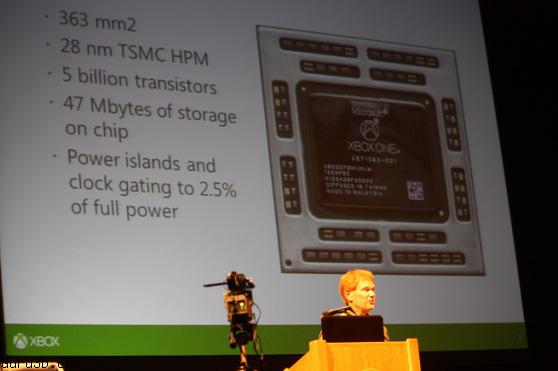Microsoft disclosed details for the main processor and the Kinect image processor in the Xbox One video game console today at a chip design conference, showing how its designers had learned the lessons of the Xbox 360′s Red Ring of Death” and have incorporated what they’ve learned into the upcoming Xbox One consoles.
As Venturebeat reports:
Those details are critical for the kind of experience that consumers will have with the Xbox One when it launches this fall. The guts inside the box will determine how the tech will affect the quality of games and whether the machine will be prone to failure, as the Xbox 360 was when it debuted in 2005.
Speaking at the Hot Chips engineering conference at Stanford University, Microsoft chip architect John Sell said the Xbox One’s main processor is a gargantuan beast, codesigned with Advanced Micro Devices and manufactured by contract chip manufacturer Taiwan Semiconductor Manufacturing Co.
The chip covers an area of 363 square millimeters and is built in a 28-nanometer state-of-the-art manufacturing process. It has 5 billion basic components, known as transistors, on a single chip that combines a microprocessor, graphics processor, and 47MB of memory.
As one member of the audience remarked, that mean it’s a big chip. Such chips are hard to manufacture, as any small defect can render a chip inoperable. And the larger a chip, the more prone it is to small defects.
Back in 2005, Microsoft and its vendors made some bad calculations, and many Xbox 360 game consoles failed from overheating. That led to a $1.1 billion write-off as Microsoft replaced failed machines for as many as one out of every two early customers. That’s why the design of the chips, while arcane, is a very important matter this time around.
To deal with the specter of defects, Sell said Microsoft designed in redundancies into the chip where it could so that if one section was inoperable, it doesn’t kill the whole chip. Nevertheless, it means that it won’t be easy to churn out millions of these chips.
Kevin Krewell, senior analyst at the chip market analyst firm Linley Group, said that TSMC routinely makes chips of this size for companies such as Nvidia, so the size shouldn’t be a barrier to manufacturing.
And that’s exactly what Microsoft needs as it prepares the launch of the Xbox One console, which is going head-to-head against Sony’s PlayStation 4, which debuts in North America on Nov. 15.
To help make the chip use less power, Microsoft designed small islands and gates within the chip that could switch off certain areas so the overall chip consumes less power. Such techniques are standard in big chip projects these days, and they mean that only the parts of a chip that are being used are drawing power.
The central processing unit (CPU) has eight 64-bit Jaguar cores designed by AMD.
The graphics section of the main processor has 15 special processors that can handle things like graphics or physics processing. Data highways can transfer bits at a rate of 200GBs per second or more across different parts of the chip. The audio subsystem has two dedicated vector cores.
The Xbox One has 8GB of shared main memory known as dynamic random access memory. It also has a Blu-ray drive and a 500GB hard disk.
Microsoft engineer Patrick O’Connor, meanwhile, talked about the design of the image processor for the motion-sensing Kinect subsystem within the Xbox One.
The Kinect uses a different way of measuring movement, based on technology acquired from Canesta. The “time of flight” technology sends out light signals and measures how much time it takes to come back. Then it calculates the shape of objects that the signals hit to determine the basic shape of a body or room. It can detect objects as small as 2.5 centimeters, O’Connor said. It can thus discern which way a child’s wrist might be facing. That is much more accurate than the Kinect for the Xbox 360 that was introduced in 2010. The new Kinect image sensor is also much faster than the previous version, with 20 millisecond latency.
The image sensor chip also controls a 1080p camera that can capture video for Skype or other purposes. Kinect now has a 70-degree viewing angle and can detect movement in larger spaces, ranging from around 0.8 meters to 4.2 meters away. Now it also doesn’t matter if the lighting in the room is good or poor. Kinect can also detect up to six players at a time now.
Microsoft disclosed some details but left many important pieces out. Evidently, Microsoft doesn’t want to tell all of its competitors about how well designed its system is.
Microsoft discloses details on Xbox One and Kinect chip


